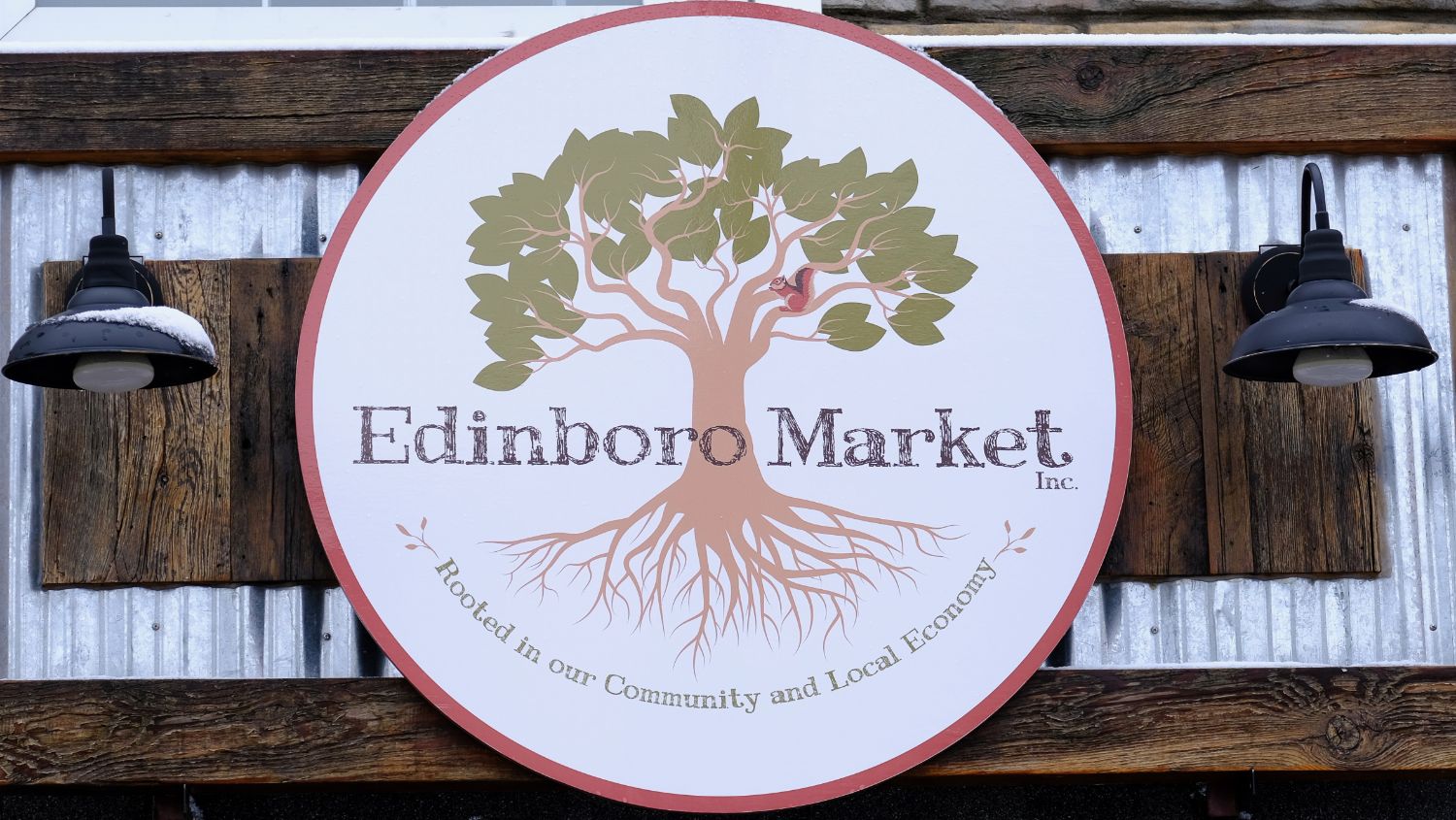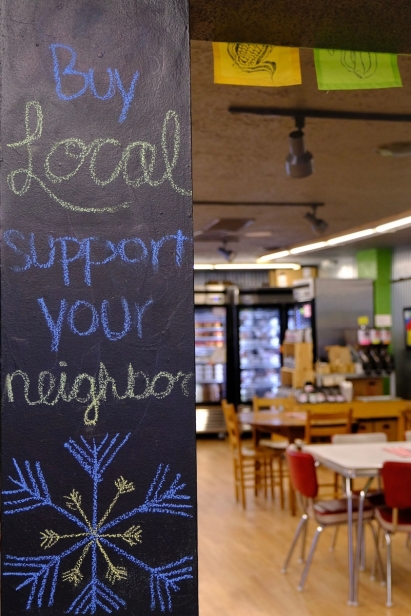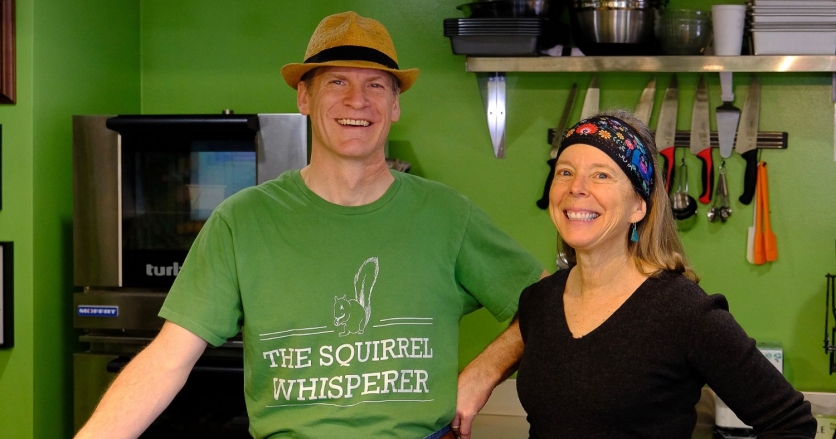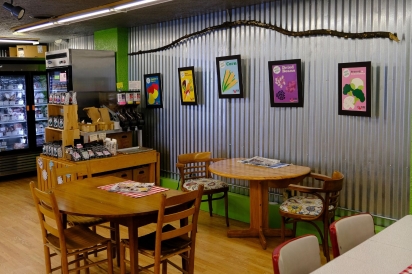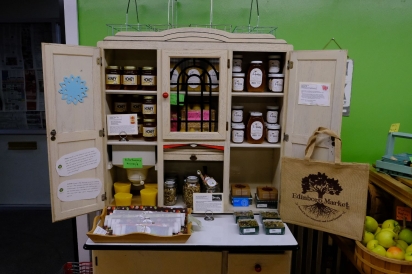Edinboro Market's Vision for a Renewed Local Food System
Sunday around 10am. Cold, a little gray. I park along the main street in Edinboro, PA, and head into the Edinboro Market, stomping off my boots. Pulling open the door, I’m greeted by light, warmth and quiet Americana music. The heartening aroma of coffee and fresh breads and confections—baked onsite at the Boro Sweet Spot—surround me as I stop by the counter to drop off last week’s glass milk bottle and empty egg cartons for reuse. My eyes glance through the food- and garden-related titles within the Market’s little free library, then scan the rest of the space for what’s new. There’s always something.
You might think, in the dead of winter or the slush of early spring, that you couldn’t enjoy much local food in Northwest PA. Or that in a region better known for its Rust Belt industrial past, you’d be hard-pressed to find so many growers and producers supplying such a wide variety of staples and specialty items—all offered affordably in one place.
Two years ago, I’d certainly have assumed these things. But each time I load up my shopping bags with milk, eggs, sweet potatoes, garlic, cheese, lettuce, wildly fragrant ginger beer and the salsa our family from foodie-heaven Brooklyn goes gaga over each time they visit, I’m reminded of what’s possible when creative people around us have the courage to pursue what they’ve imagined. And how we all benefit.
Edinboro Market emerged from the vision of Marti Martz, president of this nonprofit, and Curtis Hals, the Market’s manager and Boro Sweet Spot baker. It all started, says Martz, when the couple realized they spent a lot of Saturdays driving around Northwest PA, seeking out local tasty and nutrient-dense foods from producers scattered throughout the area. From that realization came their decision to open a market.
“I got some really good books and started thinking about it,” Martz recalls. “Then we took a road trip down to Huntington, West Virginia. There’s a market down there, also a nonprofit, that is set up like ours, and they gave us their 501(c)(3) application. We met their market manager, a board member and a farmer and just saw how they did it.”
Hals and Martz felt that the model would translate well to our region. They’ve since also discovered that between Ohio, Michigan, Pennsylvania and West Virginia, there is a handful of similar markets with the same business model.
“We have all actually connected with each other and everybody is supporting each other,” Martz says. “It’s awesome. It’s a great crew to work with, for sure.”
Their own leap into the business took less than a year. When you know, you know. In December 2017, Martz explained via email, “Edinboro Market Inc. opened to provide year-round access to fresh, local food; an entrepreneurial marketplace for food producers; and an understanding of the importance of both.”
So now, busy people who are similarly passionate about fresh, local food don’t have to spend weekends driving from place to place. And farmers and producers can dedicate more of their time to … farming and producing.
The Market’s current footprint may be small, but its impact is already substantial. In just two years of operation, Martz says, “we have returned $240,000 to our regional growers and food producers.”
Almost a quarter of a million dollars back into the local economy. In two years.
“So we feel like we’re off to a good start,” Martz says modestly.
In December, Martz told me that the Market offers 38 product lines. But as a regular shopper who’s seen how readily they diversify I’d suspect it’s more by the time you’re reading this. Martz adds that all foods and products at the Market are made or grown within 150 miles of Edinboro. Producers set their own prices, and benefit from an 80/20 split with the Market. “At the end of the month, they get 80 percent of their sales back in their pocket,” she explains. “Our point-of-sale system tracks their sales, helping them to see trends and test new products, such as specific cuts of meat or new product lines like hummus.”
Such data collection is vital to anyone tailoring their priorities to suit customers’ needs. But it’s typically beyond the scope of daily operations for those working in localized food and farming—many of whom are running their businesses alongside other full-time work.
Edinboro Market further supports local growers, farmers and producers as an incubator space. “The latest statistics I’ve seen from the USDA list 1,400-plus farms in Erie County, PA, most of them small- and mid-sized operations,” Martz explained via email. “Edinboro Market provides a year-round storefront for growers of this size. Statistics show that money spent at a local business is retained in the community at almost double the rate of money spent at a large retail chain.”
What statistics have a harder time measuring, however, is perhaps the greatest offering provided by Edinboro Market: introducing customers to the people who grow their food. Grower and producer profiles are posted near the products on offer, and the market hosts regular “meet the producer” events.
But it goes deeper than that. Hals and Martz know these producers personally, and wholeheartedly believe in them. Many weekends, Hals will greet me with an enthusiastic rundown of new products— and the first-name-basis producers trying them out.
It’s hard for me to put into words what that has meant. I don’t buy garlic and lettuce. I buy Garrett’s garlic and Amanda’s lettuce. The world feels friendlier. Food reclaims its nourishing nature from the soullessness typical of mass production.
Many of us who share a love of local know that this connection, while hard to quantify or measure with metrics, is priceless. Nevertheless, the price of goods produced on a smaller scale can place them out of reach for some. This conundrum—and the fact that the healthiest food, with the most positive environmental and health benefits, should be accessible to all—is also a major part of Edinboro Market’s greater mission.
To that end, their prices are competitive, and many align with large-scale grocers. Hals spends a lot of time helping customers to understand the embedded value in the products on offer at the Market, and the hidden costs in much of the food they might find “cheaper” elsewhere. (In fact, it’s why he’s quoted less here—he’s busy greeting the steady stream of customers who file in to stock up.) He also tells me about needing to clarify for customers what “local” actually implies, and why you’re not going to find bananas at this market.
Martz, who is a co-chair of Erie’s Food Policy Advisory Council, devotes considerable time and energy outside the Market to determine “where we can build capacity in our local food system,” she explains. “This is truly a system, with many moving parts, and it does not benefit from government assistance the way other parts of the big ag system do. Those who are trying to grow food for humans in our region, rather than corn and soybeans, wheat, etc., focus on quality over quantity, on things like soil health and animal welfare. These have costs and benefits associated with them. As do the food choices we make.”
To address the issue, the Market offers numerous free classes throughout the year, from beekeeping to yogurt making to growing microgreens. The Pennsylvania Association for Sustainable Agriculture (PASA) recently offered a food safety training course at the Market for local produce growers. And they’re working with PASA, the Young Farmers Coalition, Allegheny College and Penn State Behrend on an initiative to support new farmers in the region, Martz says.
She adds that the Market has received an Erie Community Foundation planning grant “to research the potential of a community commercial kitchen for food entrepreneurs, job skills development, basic and advanced cooking classes, etc.”
So yes—the Market is most certainly “off to a good start.”
I ask Hals what makes him feel the most hopeful.
“Plain and simple: that we’re still here, and that we have built a very loyal customer base,” he says. This undoubtedly has a lot to do with the breads and goodies Hals bakes, often inspired by customer requests. “I don’t like to do the things that everybody else does,” he adds. His unique creations draw folks who’ve arrived on two feet, two wheels—you name it. And just enough café seating provides a cozy resting spot to savor the fruits of his labor.
Meanwhile, Hals adds, “We have a lot of things churning,” including branching out further into prepared foods.
It’s all just a matter of time.
But already, Edinboro Market has nourished the region it serves. Already, Hals and Martz have created a community gathering place in the center of town, bucking the trend toward corporatization. Already, this small market in a small town has galvanized the conversation around building a regional food system that will be sustainable, healthy, delicious and just—for all.


